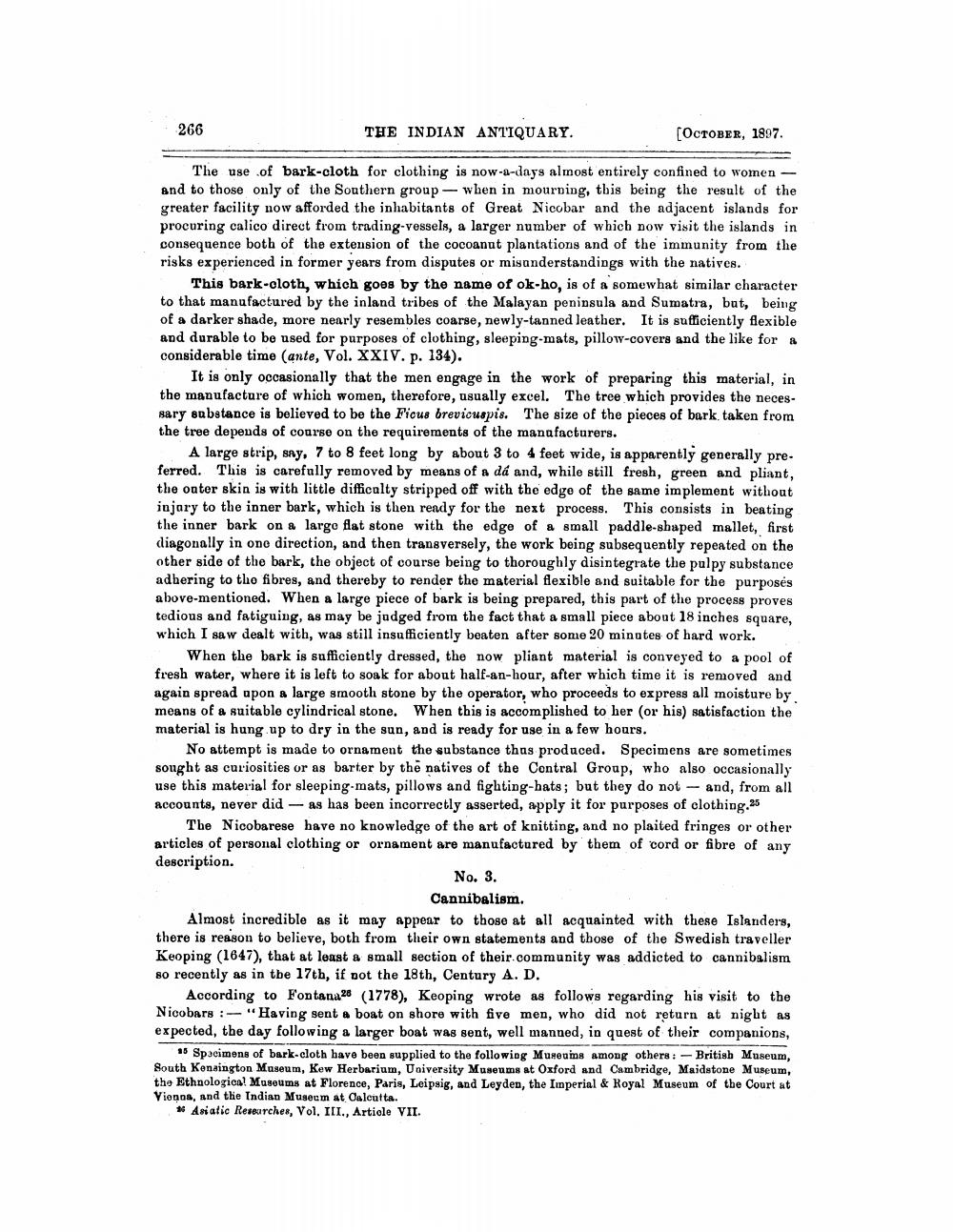________________
266
THE INDIAN ANTIQUARY.
[OCTOBER, 1897.
The use of bark-cloth for clothing is now-a-days almost entirely confined to women – and to those only of the Southern group - when in mourning, this being the result of the greater facility now afforded the inhabitants of Great Nicobar and the adjacent islands for procuring calico direct from trading-vessels, a larger number of which now visit the islands in consequence both of the extension of the cocoanut plantations and of the immunity from the risks experienced in former years from disputes or misunderstandings with the natives.
This bark-cloth, which goes by the name of ok-ho, is of a somewhat similar character to that manufactured by the inland tribes of the Malayan peninsula and Sumatra, bat, being of a darker shade, more nearly resembles coarse, newly-tanned leather. It is sufficiently flexible and durable to be used for purposes of clothing, sleeping.mats, pillow-covers and the like for a considerable time (ante, Vol. XXIV. p. 134).
It is only occasionally that the men engage in the work of preparing this material, in the manufacture of which women, therefore, usually excel. The tree which provides the necessary substance is believed to be the Ficus brevicuspis. The size of the pieces of bark taken from the tree depends of course on the requirements of the manufacturers.
A large strip, say, 7 to 8 feet long by about 3 to 4 feet wide, is apparently generally pre. ferred. This is carefully removed by means of a dá and, while still fresh, green and pliant, the outer skin is with little difficulty stripped off with the edge of the same implement without injary to the inner bark, which is then ready for the next process. This consists in beating the inner bark on a large flat stone with the edge of a small paddle-shaped mallet, first diagonally in one direction, and then transversely, the work being subsequently repeated on the other side of the bark, the object of course being to thoroughly disintegrate the pulpy substance adhering to tlo fibres, and thereby to render the material flexible and suitable for the purposes above-mentioned. When a large piece of bark is being prepared, this part of the process proves tedious and fatiguing, as may be judged from the fact that a small piece about 18 inches square, which I saw dealt with, was still insufficiently beaten after some 20 minutes of hard work.
When the bark is sufficiently dressed, the now pliant material is conveyed to a pool of fresh water, where it is left to soak for about half-an-hour, after which time it is removed and again spread apon a large smooth stone by the operator, who proceeds to express all moisture by means of a suitable cylindrical stone. When this is accomplished to her (or his) satisfaction the material is hung up to dry in the sun, and is ready for use in a few hours.
No attempt is made to ornament the substance thas produced. Specimens are sometimes sought as curiosities or as barter by the natives of the Contral Group, who also occasionally use this material for sleeping.mats, pillows and fighting-hats; but they do not - and, from all accounts, never did - as has been incorrectly asserted, apply it for purposes of clothing 25
The Nicobarese have no knowledge of the art of knitting, and no plaited fringes or other articles of personal clothing or ornament are manufactured by them of cord or fibre of any description.
No. 3.
Cannibalism. Almost incredible as it may appear to those at all acquainted with these Islanders, there is reason to believe, both from their own statements and those of the Swedish traveller Keoping (1647), that at least a small section of their community was addicted to cannibalism 80 recently as in the 17th, if not the 18th, Century A. D.
According to Fontana26 (1778), Keoping wrote as follows regarding his visit to the Nicobars : - "Having sent a boat on shore with five men, who did not return at night as expected, the day following a larger boat was sent, well manned, in quest of their companions,
15 Spacimens of bark cloth have been supplied to the following Museums among others: - British Museum, South Kensington Museum, Kew Herbarium, University Museums at Oxford and Cambridge, Maidstone Museum, the Ethnological Museums at Florence, Paris, Leipsig, and Leyden, the Iinperial & Royal Museum of the Court at Viongs, and the Indian Museum at Calcutta.
* Asiatic Resourches, Vol. III., Artiole VII.




